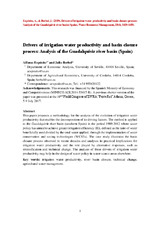Mostrar el registro sencillo del ítem
Drivers of Irrigation Water Productivity and Basin Closure Process: Analysis of the Guadalquivir River Basin (Spain)
| dc.contributor.author | Expósito, Alfonso | |
| dc.contributor.author | Berbel, Julio | |
| dc.date.accessioned | 2021-10-29T08:12:22Z | |
| dc.date.available | 2021-10-29T08:12:22Z | |
| dc.date.issued | 2019 | |
| dc.identifier.uri | http://hdl.handle.net/10396/21997 | |
| dc.description.abstract | This paper proposes a methodology for the analysis of the evolution of irrigation water productivity that enables the decomposition of its driving factors. The method is applied to the Guadalquivir river basin (southern Spain) in the period 1989-2012 where water policy has aimed to achieve greater irrigation efficiency (IE), defined as the ratio of water beneficially used divided by the total water applied, through the implementation of water conservation and saving technologies (WCSTs). The case study illustrates the basin closure process observed in recent decades and analyses its practical implications for irrigation water productivity and the role played by alternative responses, such as intensification and technical change. The analysis of these drivers of irrigation water productivity may help in the design of water policy in water-scarce areas elsewhere. | es_ES |
| dc.format.mimetype | application/pdf | es_ES |
| dc.language.iso | eng | es_ES |
| dc.publisher | Springer | es_ES |
| dc.rights | https://creativecommons.org/licenses/by-nc-nd/4.0/ | es_ES |
| dc.source | Water Resources Management 33, 1439-1450 (2019) | es_ES |
| dc.subject | Irrigation water productivity | es_ES |
| dc.subject | River basin closure | es_ES |
| dc.subject | Technical change | es_ES |
| dc.subject | Agricultural water management | es_ES |
| dc.title | Drivers of Irrigation Water Productivity and Basin Closure Process: Analysis of the Guadalquivir River Basin (Spain) | es_ES |
| dc.type | info:eu-repo/semantics/article | es_ES |
| dc.relation.publisherversion | https://doi.org/10.1007/s11269-018-2170-7 | es_ES |
| dc.relation.projectID | Gobierno de España. AGL2014-53417-R | es_ES |
| dc.rights.accessRights | info:eu-repo/semantics/openAccess | es_ES |

